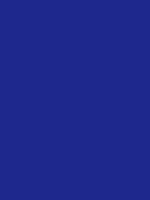#1e288d Color Information
In a RGB color space, hex #1e288d is composed of 11.8% red, 15.7% green and 55.3% blue. Whereas in a CMYK color space, it is composed of 78.7% cyan, 71.6% magenta, 0% yellow and 44.7% black. It has a hue angle of 234.6 degrees, a saturation of 64.9% and a lightness of 33.5%. #1e288d color hex could be obtained by blending #3c50ff with #00001b. Closest websafe color is: #333399.
-
- R 12
- G 16
- B 55
-
- C 79
- M 72
- Y 0
- K 45
● #1e288d color description : Dark blue.
#1e288d Color Conversion
The hexadecimal color #1e288d has RGB values of R:30, G:40, B:141 and CMYK values of C:0.79, M:0.72, Y:0, K:0.45. Its decimal value is 1976461.
| Hex triplet | 1e288d | #1e288d |
|---|---|---|
| RGB Decimal | 30, 40, 141 | rgb(30,40,141) |
| RGB Percent | 11.8, 15.7, 55.3 | rgb(11.8%,15.7%,55.3%) |
| CMYK | 79, 72, 0, 45 | |
| HSL | 234.6°, 64.9, 33.5 | hsl(234.6,64.9%,33.5%) |
| HSV (or HSB) | 234.6°, 78.7, 55.3 | |
| Web Safe | 333399 | #333399 |
| CIE-LAB | 22.71, 33.341, -56.688 |
|---|---|
| XYZ | 6.101, 3.716, 25.594 |
| xyY | 0.172, 0.105, 3.716 |
| CIE-LCH | 22.71, 65.766, 300.462 |
| CIE-LUV | 22.71, -6.436, -67.037 |
| Hunter-Lab | 19.278, 22.755, -65.221 |
| Binary | 00011110, 00101000, 10001101 |
Color Schemes with #1e288d
Alternatives to #1e288d
Below, you can see some colors close to #1e288d. Having a set of related colors can be useful if you need an inspirational alternative to your original color choice.
#1e288d Preview
This text has a font color of #1e288d.
<span style="color:#1e288d;">Text here</span>This paragraph has a background color of #1e288d.
<p style="background-color:#1e288d;">Content here</p>This element has a border color of #1e288d.
<div style="border:1px solid #1e288d;">Content here</div>.text {color:#1e288d;}.background {background-color:#1e288d;}.border {border:1px solid #1e288d;}Shades and Tints of #1e288d
A shade is achieved by adding black to any pure hue, while a tint is created by mixing white to any pure color. In this example, #02030c is the darkest color, while #fafbfe is the lightest one.
-
#02030c
#02030crgb(2,3,12) -
#06081c
#06081crgb(6,8,28) -
#090c2c
#090c2crgb(9,12,44) -
#0d113c
#0d113crgb(13,17,60) -
#10164c
#10164crgb(16,22,76) -
#141a5c
#141a5crgb(20,26,92) -
#171f6d
#171f6drgb(23,31,109) -
#1b237d
#1b237drgb(27,35,125) -
#1e288d
#1e288drgb(30,40,141) -
#212d9d
#212d9drgb(33,45,157) -
#2531ad
#2531adrgb(37,49,173) -
#2836be
#2836bergb(40,54,190) -
#2c3ace
#2c3acergb(44,58,206)
-
#3846d5
#3846d5rgb(56,70,213) -
#4955d8
#4955d8rgb(73,85,216) -
#5964dc
#5964dcrgb(89,100,220) -
#6974df
#6974dfrgb(105,116,223) -
#7983e2
#7983e2rgb(121,131,226) -
#8992e6
#8992e6rgb(137,146,230) -
#99a1e9
#99a1e9rgb(153,161,233) -
#aab0ed
#aab0edrgb(170,176,237) -
#babff0
#babff0rgb(186,191,240) -
#cacef4
#cacef4rgb(202,206,244) -
#daddf7
#daddf7rgb(218,221,247) -
#eaecfb
#eaecfbrgb(234,236,251) -
#fafbfe
#fafbfergb(250,251,254)
Tones of #1e288d
A tone is produced by adding gray to any pure hue. In this case, #535358 is the less saturated color, while #0412a7 is the most saturated one.
-
#535358
#535358rgb(83,83,88) -
#4c4e5f
#4c4e5frgb(76,78,95) -
#454866
#454866rgb(69,72,102) -
#3f436c
#3f436crgb(63,67,108) -
#383e73
#383e73rgb(56,62,115) -
#323879
#323879rgb(50,56,121) -
#2b3380
#2b3380rgb(43,51,128) -
#252d86
#252d86rgb(37,45,134) -
#1e288d
#1e288drgb(30,40,141) -
#172394
#172394rgb(23,35,148) -
#111d9a
#111d9argb(17,29,154) -
#0a18a1
#0a18a1rgb(10,24,161) -
#0412a7
#0412a7rgb(4,18,167)
Color Blindness Simulator
Below, you can see how #1e288d is perceived by people affected by a color vision deficiency. This can be useful if you need to ensure your color combinations are accessible to color-blind users.
